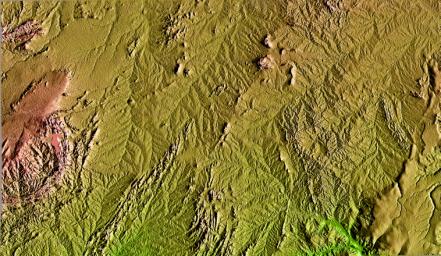This topographic image is the first to show the full 240-kilometer-wide (150 mile) swath collected by the Shuttle Radar Topography Mission (SRTM). The area shown is in the state of Bahia in Brazil. The semi-circular mountains along the left side of the image are the Serra Da Jacobin, which rise to 1100 meters (3600 feet) above sea level. The total relief shown is approximately 800 meters (2600 feet). The top part of the image is the Sertao, a semi-arid region, that is subject to severe droughts during El Niño events. A small portion of the San Francisco River, the longest river (1609 kilometers or 1000 miles) entirely within Brazil, cuts across the upper right corner of the image. This river is a major source of water for irrigation and hydroelectric power. Mapping such regions will allow scientists to better understand the relationships between flooding cycles, drought and human influences on ecosystems.
This shaded relief image was generated using topographic data from the Shuttle Radar Topography Mission. A computer-generated artificial light source illuminates the elevation data to produce a pattern of light and shadows. Slopes facing the light appear bright, while those facing away are shaded. On flatter surfaces, the pattern of light and shadows can reveal subtle features in the terrain. Colors show the elevation as measured by SRTM. Colors range from green at the lowest elevations to reddish at the highest elevations. Shaded relief maps are commonly used in applications such as geologic mapping and land use planning.
The Shuttle Radar Topography Mission (SRTM), launched on February 11, 2000, uses the same radar instrument that comprised the Spaceborne Imaging Radar-C/X-Band Synthetic Aperture Radar (SIR-C/X-SAR) that flew twice on the Space Shuttle Endeavour in 1994. The mission is designed to collect three-dimensional measurements of the Earth's surface. To collect the 3-D data, engineers added a 60-meter-long (200-foot) mast, an additional C-band imaging antenna and improved tracking and navigation devices. The mission is a cooperative project between the National Aeronautics and Space Administration (NASA), the National Imagery and Mapping Agency (NIMA) and the German (DLR) and Italian (ASI) space agencies. It is managed by NASA's Jet Propulsion Laboratory, Pasadena, CA, for NASA's Earth Science Enterprise, Washington, DC.

 Planetary Data System
Planetary Data System












